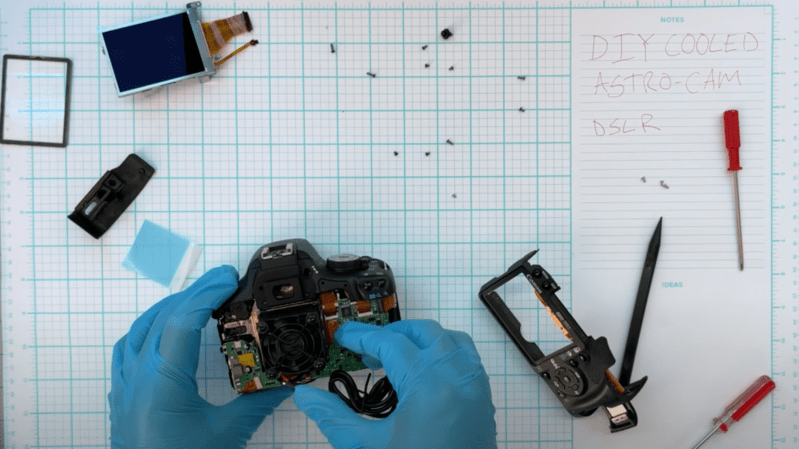When taking pictures of the night sky, any noise picked up by the sensor can obscure the desired result. One major cause of noise in CMOS sensors is heat—even small amounts can degrade the final image. To combat this, [Francisco C] of Deep SkyLab retrofitted an old Canon T1i DSLR with an external cooler to reduce thermal noise, which introduces random pixel variations that can hide faint stars.
While dedicated astrophotography cameras exist—and [Francisco C] even owns one—he wanted to see if he could improve an old DSLR by actively cooling its image sensor. He began with minor surgery, removing the rear panel and screen to expose the back of the sensor. Using a sub-$20 Peltier cooler (also called a TEC, or Thermoelectric Cooler), he placed its cold side against the sensor, creating a path to draw heat away.
Reassembling the camera required some compromises, such as leaving off the LCD screen due to space constraints. To prevent light leaks, [Francisco C] covered the exposed PCBs and viewfinder with tape. He then tested the setup, taking photos with the TEC disabled and enabled. Without cooling, the sensor started at 67°F but quickly rose to 88°F in sequential shots. With the TEC enabled, the sensor remained steady at 67°F across all shots, yielding a 2.8x improvement in the signal-to-noise ratio. Thanks to [Francisco C] for sharing this project! Check out his project page for more details, and explore our other astrophotography hacks for inspiration.
















A cool project
Gives me the chills…
Very cool project, time to put those peltiers in the drawer to a good use. Maybe I can use the peltier’s warm side to keep the scope free from condensation too!
But… Why Fahrenheit is still being used is the biggest question of our generation.
The standard equations for thermal noise use Kelvin, so for reference:
67°F = 19.444°C = 292.594K
88°F = 31.111°C = 304.261K (a 3.987% change)
This brought up a memory from the dark ages of amateur astrophotography, when film was still used. Celestron (I think) developed a cold camera that used dry ice to cool the emulsion. This greatly reduced reciprocity failure of room-temperature emulsion, in which increasingly long exposures did not provide proportionally-greater sensitivity.
I don’t get how he gets a 2.8x better SNR. Thermal noise is proportional to temperature and bandwidth but that temperature is referenced to absolute zero. A 20ish difference in degrees F can’t account for what he claims.
I guess that is the case for thermal noise generated after the sensor, but probably in this case is limited by thermal noise before the sensor so that the highly non-linearity of the CMOS response modifies natural proportional response to temperature (which probably is optimized for general photography an temperatures but not for astrophotography with far less photons per seconds). I have found this article that seems to show the importance of themperature on scientific CMOS cameras https://andor.oxinst.com/learning/view/article/te-cooling-of-scmos so it seems temperature is indeed quite relevant. I am no expert in any case, just wondering myself too due to your question.
Rule of thumb from the good old days of CCDs (80s & 90s) was the dark noise (“thermal noise”) increased by a factor of two every ten degrees C. Noise processes in CMOS imagers are somewhat different, but a similar relation would hold for them.
Dark current in a CMOS pixel is exponential with temperature, not linear. It doubles roughly every 8C. Presuming he is doing long exposures and so limited by dark current, a little more than half the dark current for cooling a little more than 8C is about right.
Looking at the temperatures, I think a more performant TEC should have been used along with a proper heatsink on the hot side allowing for much lower temperatures (perhaps subzero) on the cold side
Great if you have a hermetically sealed sensor, including its pins and adjacent circuit board. Otherwise dew is very much not your friend.
I tec cooled my t3i and full spectrum modded it. I did it without hacking the camera case, connectors, etc, actually you can’t tell it’s modded except the thermal couple wire.
Let me clarify, I can remove the tecs, heatsink and fan and it looks normal camera.
What I did was place thermal padding from the back of the sensor, to the back of the camera, I flip the screen open, place a thermal pad on the plastic, dual 12v 60w tecs ($3 each) and a heatsink/fan. I run the tecs at 3.5v each (7v when connected in series and about 800mA, about 6w total). Without the tecs running on 70f room temp, the sensor gets to 95f, with the tec on, it drops to 55f, 40f delta. The dark noise is night and day. Yes, I could go colder but dew is not your friend.
Here the results, view on a PC
https://www.flickr.com/photos/123906448@N08/30761822970
Disassembly of these cameras is safer/easier than I thought. Opening the back panel doesn’t expose the optics. Maybe I could add cooling to my overheating 4k camera.
One trick I came up with is, take a fine sharpie, and mark how far the ribbon cables are inverted (with a line) before you remove them. This way you know they are fully inverted when reassembling the camera. Also note some connected flip tab can be reversed (flips up from the back side), careful visual inspection before flipping it is wise). Also read how I called mine above for an option.
^inverted^ = incerted